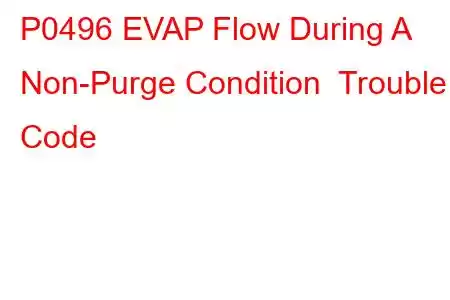P0496 EVAP Flow During Non-Purge Condition
OBD-II Trouble Code Technical Description
EVAP (evaporative emission) Flow During A Non-Purge Condition
What does that mean?
This diagnostic trouble code (DTC) is a generic powertrain code, which means that it applies to OBD-II equipped vehicles. Although generic, the specific repair steps may vary depending on make/model.
A quick search on the 'net shows that this code seems to be more common with GM (Chevy, Pontiac, etc.) vehicles. In Acura, Honda, Hyundai, Kia, and Mazda vehicles, this code is described "EVAP system high purge flow" which is the same thing.
This DTC checks for undesired intake vacuum flow to the EVAP system. The control module seals the EVAP system by commanding the EVAP canister purge solenoid valve OFF and the EVAP canister vent solenoid valve ON. The control module monitors the fuel tank pressure (FTP) sensor to determine if a vacuum is being drawn on the EVAP system
If vacuum in the EVAP system is more than a predetermined value within a predetermined time, this code is set and the MIL (malfunction indicator lamp) is illuminated.
Symptoms
Symptoms of a P0496 DTC will include Malfunction Indicator Lamp (MIL) illumination, and most likely no other noticeable symptoms. Some may experience a hard start / crank condition. In some cases the engine may run rich which may not detected, but can cause damage long-term (think: catalytic converter damage).
Potential Causes
Potential causes of a P0496 EVAP code include:
Faulty purge or vent solenod/valve Plugged EVAP canister Failed EVAP / fuel pressure sensor Poor electrical connection Short electrical circuit condition (Hyundai, Isuzu) Faulty canister purge valve Blocked vapor canister Faulty vent solenoid Leaking EVAP system hose (Hyundai) Faulty purge flow sensor (Kia, Mazda)Possible Solutions
The most common fix for this DTC is to replace the purge solenoid valve. However, be sure to do a proper diagnosis before replacing parts!
Ideally you would use an advanced scan tool, with the ignition on and engine off, you seal the EVAP system using the Seal/Purge function. Then, watch the fuel tank pressure sensor reading when you turn the purge off. If the pressure value is higher than the normal range set by the manufacturer, replace the EVAP canister purge solenoid valve. Refer to a model-specific repair guide for the proper specification.
If you don't have access to the scan tool, you could always disconnect the vacuum line at the purge valve going back to the charcoal canister. Unplug the electrical connector on the purge valve, start the engine, then put your finger on the valve where you disconnected the line. If you can feel vacuum there, the purge solenoid valve is faulty and needs to be replaced. Alternately, you could simply remove the purge solenoid valve and blow into it. It is normally closed, so if air goes through then you need to replace it.
If the purge valve checks out good, either the problem with the valve is intermittent or there is a problem with the fuel tank pressure sensor. To test the fuel tank pressure sensor you will need to have a high end scan tool to monitor the tank pressure with the gas cap removed. If the sensor shows vacuum with the gas cap removed, there is a problem with the fuel tank pressure sensor.
Here is a picture of one purge solenoid valve. Yours may look similar or different, consult a factory service guide or your local vehicle dealership for more details:
Read: 51


